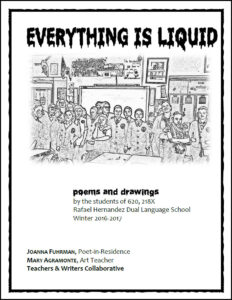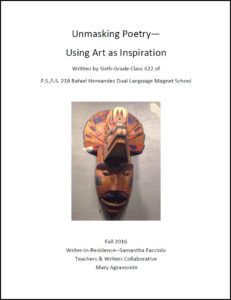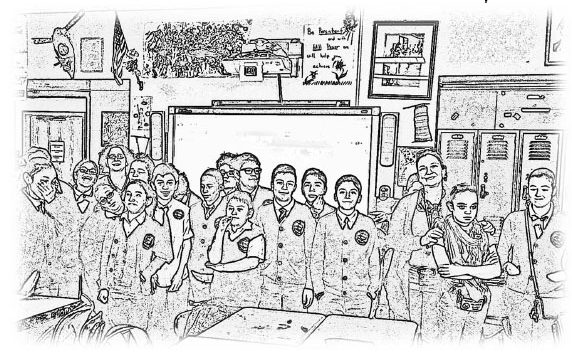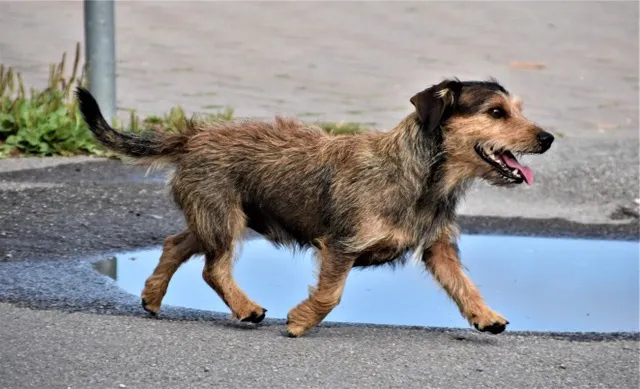
To the students of 218X
(from the introduction to the anthology Everything is Liquid)
This was a very special residency for me because Ms. Agramonte suggested we take the students to the Museum of Natural History and write poems and draw images inspired by the Northwestern mask exhibit. Her students had been studying masks from around the world, and we wanted to build on the work they had already done. I thought it would also be fun to take them to the adjacent North American mammal diorama room, too, and have them work on poems inspired by the animals.
You will see a range of types of poems in this collection. Some were written on the first day, when I introduced the students to the ideas of dream poetry and using metaphors to write about animals. In preparation, we read poetry from around the world, including poems by Nicanor Parra, Elliot Katz, Ted Hughes, Anthony Hecht, William Carlos Williams and Federico García Lorca. Other poems were written during and after our visit to the museum. The students always asked thoughtful questions, and I was happy to see them listening to the sound of the words in their own poems and using their language to create pictures with words.
It was an honor to work with such a talented group of young people and such an inspiring teacher!
—Joanna Fuhrman
From the introduction to the anthology Unmasking Poetry—Using Art as Inspiration

This poetry project originated with art teacher Mary Agramonte’s desire to teach her students about mask making. Drawing on the ancient masks of the native peoples of the Pacific Northwest as models, she encouraged students to reach back into their own cultural and familial backgrounds to create masks that held some unique cultural significance. Some students incorporated the colors of the flag of their families’ homelands into their masks, whereas others incorporated different elements of design or animal representation.
As a class, we traveled to the American Museum of Natural History to study the masks of the native tribes of the Pacific Northwest in the context of other artifacts in the Hall of the Northwest Coast Indians. There, surrounded by tapestries, totem poles, and other reminders of this rich history, we considered the significance and uses of the masks for these native peoples and how, by translation, students saw masks in their own family histories. The students drew sketches of masks that represented eagles, wolves, bears, and other elements of Northwest life, and they reflected on the masks they had created.
Back in the classroom, we read poetry by the Kwaikiutl people as well as poems by Lorna Dee Cervantes, Richard Blanco, Lewis Carroll, Jacqueline Bouvier, Langston Hughes, Alberto Ríos, and others. It was here, surrounded by multiple mediums of art, that students were able to synthesize what they’d learned through mask making and their field trip into written form. Students were free to interpret their definition of “mask” in many forms, and we discussed the many visions the students had. Some wrote poetry that reflected the masks they’d made, others imagined the lives of their favorite masks from the museum exhibit, and still others explored the mask as a celebration of heritage or commentary on society.
The final unique element in this project was the inclusion of Spanish language. The students who wrote the poems in this anthology attend a Spanish-English magnet school in the Bronx, and many of them are dual-language speakers in their own lives. Therefore, many of the poems in this book are written in Spanish as well as in English. Overall, this project was a mixture of not only mediums but also of experiences, of writing and visual art, of cultures familiar and new, and of poetry that blends both forms and languages. I hope you enjoy reading the enclosed poems as much as I enjoyed working with the students on creating them.
Teachers & Writers Magazine is published by Teachers & Writers Collaborative as a resource for teaching the art of writing to people of all ages. The online magazine presents a wide range of ideas and approaches, as well as lively explorations of T&W’s mission to celebrate the imagination and create greater equity in and through the literary arts.



